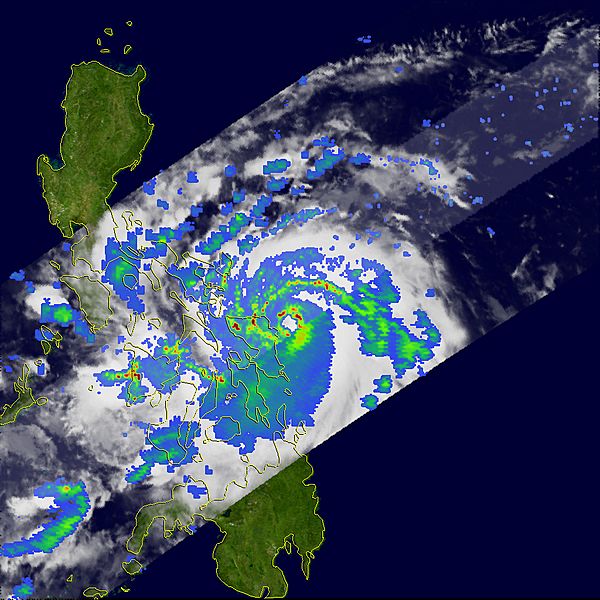Image: TY Xangsane 20060926 TRMM

Description: Typhoon Xangsane (known as Milenyo in the Philippines) brought strong winds and heavy rain to the central Philippines after making landfall on the island of Samar. The storm was reported to have had winds gusting to 150 kilometers per hour (93 miles per hour) as it made landfall. Xangsane began as a tropical depression (area of low air pressure) on September 25, 2006, in the western Philippine Sea just 320 kilometers (200 miles) east of the central islands. As Xangsane headed west-northwest towards the central Philippines, the storm system at first grew only slowly, remaining a tropical storm at the start of the day on September 26. However, as it was nearing Samar, Xangsane began to intensify rapidly into a Category 2 typhoon. This image of Typhoon Xangsane shows the storm system at 1:36 p.m. (21:36 UTC) on September 26, as observed by the Tropical Rainfall Measuring Mission (TRMM) satellite. It shows Xangsane bearing down on northern Samar in the central Philippines. Xangsane had a complete eyewall (ring of clouds around the eye), with moderate to heavy rain (green ring with areas of red) surrounded by spiral rain bands. These features show the well-developed circulation typical of a mature tropical cyclone. At the time of these images, Xangsane was estimated to have had sustained winds of 120 kilometers per hour (75 mph), making it a minimal Category 1 typhoon. However, the storm was in the process of intensifying, and it became a Category 2 storm just hours later as it drew closer to Samar. The TRMM satellite was placed into service in November 1997. From its low-earth orbit, TRMM provides valuable images and information on storm systems around the tropics using a combination of passive microwave and active radar sensors, including the first precipitation radar in space. TRMM is a joint mission between NASA and the Japanese space agency, JAXA.
Title: TY Xangsane 20060926 TRMM
Credit: http://earthobservatory.nasa.gov/NaturalHazards/natural_hazards_v2.php3?img_id=13902
Author: Image produced by Hal Pierce (SSAI/NASA GSFC) and caption by Steve Lang (SSAI/NASA GSFC)
Permission: This file is in the public domain in the United States because it was solely created by NASA. NASA copyright policy states that "NASA material is not protected by copyright unless noted". (See Template:PD-USGov, NASA copyright policy page or JPL Image Use Policy.) Warnings: Use of NASA logos, insignia and emblems is restricted per U.S. law 14 CFR 1221. The NASA website hosts a large number of images from the Soviet/Russian space agency, and other non-American space agencies. These are not necessarily in the public domain. Materials based on Hubble Space Telescope data may be copyrighted if they are not explicitly produced by the STScI.[1] See also and Template:Cc-Hubble. The SOHO (ESA & NASA) joint project implies that all materials created by its probe are copyrighted and require permission for commercial non-educational use. [2] Images featured on the Astronomy Picture of the Day (APOD) web site may be copyrighted. [3] The National Space Science Data Center (NSSDC) site has been known to host copyrighted content even though its photo gallery FAQ states that all of the images in the photo gallery are in the public domain.
Usage Terms: Public domain
License: Public domain
Attribution Required?: No
Image usage
The following page links to this image:

